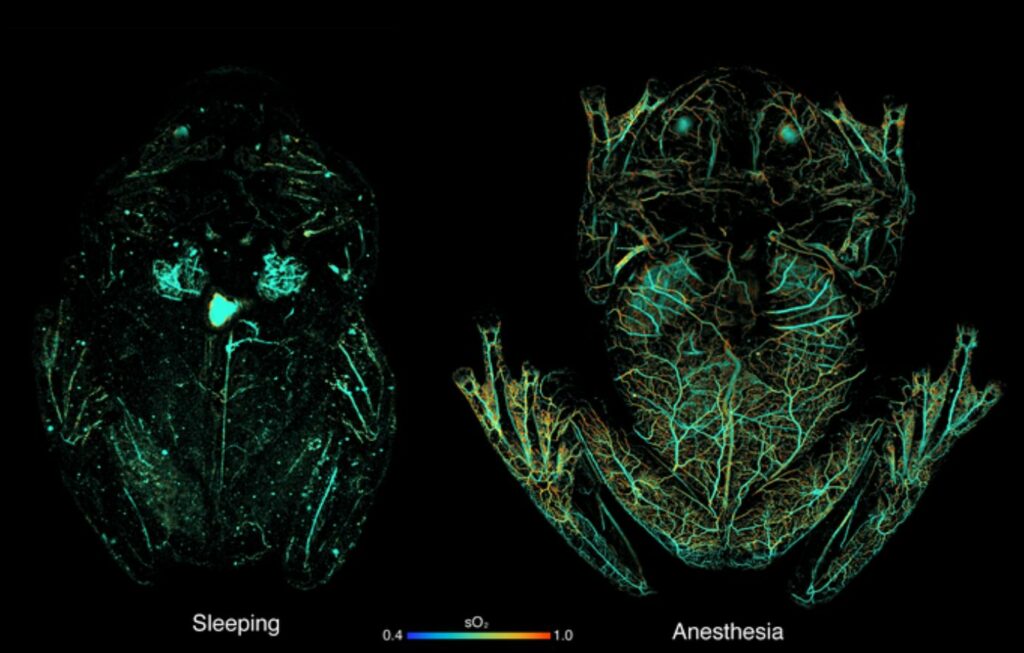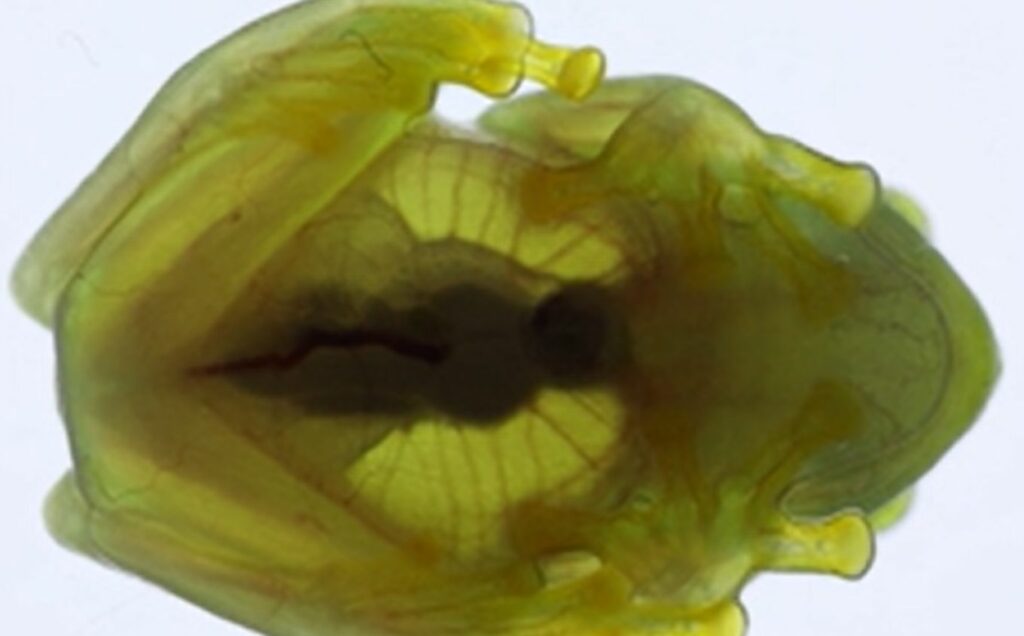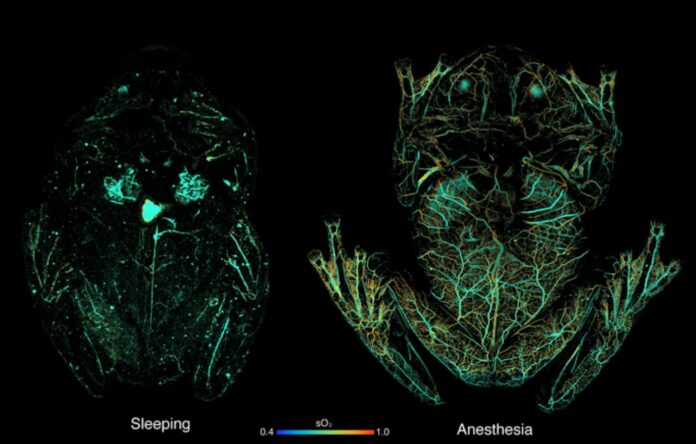When living in the wild, a glass frog is easy to miss. The northern glass frog, also known as Hyalinobatrachium fleischmanni, is just a few centimeters long and is most active at night when its green skin allows it to blend in with the leaves and vegetation that surrounds it.
But when these amphibians sleep during the day, they become real experts at hiding.
“When glassfrogs are resting, their muscles and skin become transparent, and their bones, eyes and internal organs are all that’s visible,” explains co-author Carlos Taboada. “These frogs sleep on the bottoms of large leaves, and when they’re transparent, they can perfectly match the colors of the vegetation.”
Transparent or changing skin color is a trait shared by many marine species but far less common on land. It is difficult to reach transparency for a number of reasons, one of which is that the circulatory system contains red blood cells. The green light that is often reflected by plants and other flora is easily absorbed by red blood cells. In exchange, these oxygen-rich cells reflect red light, making the blood and, by extension, the circulatory system strikingly visible, particularly against a brilliant green leaf.

Glassfrogs are among the only terrestrial vertebrates capable of achieving transparency, making them a focus of research. Taboada started studying glass frogs when he was a post-doctoral fellow in the lab of Sonke Johnsen, a biology professor at Duke who specializes in studying transparency. Working with Jesse Delia, who went all over the world to find different glassfrogs for the study, they saw that red blood cells seemed to disappear from the blood when the frogs became transparent.
They did more imaging tests on the animals and used optical models to show that the animals could become clear because they were pushing red blood cells out of their blood vessels. He thought that the cells were being kept in an organ inside the frog that was wrapped in a reflective membrane.

Despite being see-through, the biology of this animal was surprisingly difficult to understand. Experts in biology and biomedical engineering from institutions such as Duke, the American Museum of Natural History, Stanford University, and the University of Southern California contributed to this study.
“If these frogs are awake, stressed or under anesthesia their circulatory system is full of red blood cells and they are opaque,” explains Delia. “The only way to study transparency is if these animals are happily asleep, which is difficult to achieve in a research lab. We were really banging our heads against the wall for a solution.”
While researching biliverdin, the substance responsible for the characteristic green hue of several species of frogs, Taboada came upon an imaging method known as photoacoustic microscopy (PAM). In PAM, a laser beam is safely sent into the tissue, where it is absorbed by molecules and transformed into ultrasonic waves. Then, using these sound waves, precise biological pictures of the molecules are created. The imaging device is non-intrusive, silent, sensitive, and fortunately accessible at Duke.
“PAM is the ideal tool for non-invasive imaging of red blood cells because you don’t need to inject contrast agents, which would be very difficult for these frogs,” adds Junjie Yao, an assistant professor of Biomedical Engineering at Duke who specializes in PAM technologies. “The red blood cells themselves provide the contrast, because different types of cells absorb and reflect different wavelengths of light. We could optimize our imaging systems to specifically look for red blood cells and track how much oxygen was circulating in the frog’s bodies.”
Frogs were imaged by placing them upside down in a petri dish, as they would do while resting on a leaf, then shining a green laser on them. The frog’s red blood cells absorbed the green light and generated ultrasonic vibrations, which were picked up by an acoustic sensor with excellent spatial resolution and sensitivity, allowing researchers to track the cells’ movements.
The results were shockingly clear: when the frogs were sleeping, they took out and stored in their livers nearly 90% of the red blood cells that were in their bloodstream.
In more tests, the team also saw that red blood cells left the liver and moved around the body when the frogs were active. When the frogs were resting, the red blood cells came back together in the liver.
“The primary result is that whenever glassfrogs want to be transparent, which is typically when they’re at rest and vulnerable to predation, they filter nearly all the red blood cells out of their blood and hide them in a mirror-coated liver — somehow avoiding creating a huge blood clot in the process,” adds Johnsen. “Whenever the frogs need to become active again, they bring the cells back into the blood stream, which gives them the metabolic capacity to move around.”
Delia and Taboada say that this process makes them wonder how the frogs can safely store almost all of their red blood cells in their liver without forming clots or hurting the other parts of their bodies. They said that the next step could be to learn more about this mechanism and how it could one day help people with vascular problems.
This study also offers glassfrogs as a relevant research model, particularly when used in conjunction with cutting-edge photoacoustic imaging. They have studied glassfrogs for a long time and are thrilled to have fresh research opportunities and potential partners.
“We can learn more about the glassfrog’s physiology and behavior, or we can use these models to optimize imaging tools for biomedical engineering,” Delia adds. “This started because Carlos and I thought this frog was doing something weird with its blood, and it led to productive collaborations both at Duke and across the globe.”
“Our successful collaboration has been a great example of how multiple disciplines can jointly advance science in the most synergistic way,” adds Yao. “We are extremely excited about the future interactions between the biology and engineering teams. With all the strength on board, the sky is the limit.”
Source: 10.1126/science.abl6620
Image Credit: Jesse Delia / Carlos Taboada
